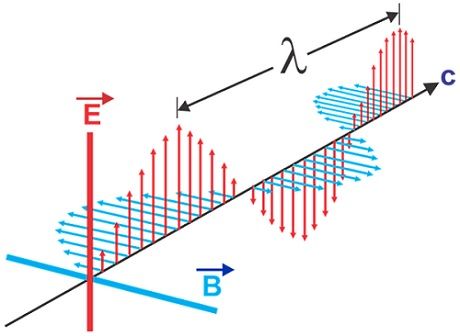The electromagnetic and matter waves are the two out of three major categories in which waves are classified. The significant difference between the electromagnetic wave and matter wave is that an electromagnetic wave is composed of electric and magnetic field components. As against in matter wave, no such field components exist.
We all know that waves are regarded as disturbance where there are continuous oscillations of constituents at a specific point or in the nearby points. In this way, a wave allows the information and energy to get propagated from one point to another but without the physical transfer of matter.
Waves are differentiated on the basis of characteristics possessed by them. Mainly, the orientation of particles, motion, and direction of energy are crucial characteristics. Hence, waves are of 3 types which are mechanical, electromagnetic, and matter waves.
Content: Electromagnetic Vs Matter Wave
Comparison Chart
Definition of Electromagnetic Wave
Electromagnetic wave also called EM wave is an outcome of the oscillating electric and magnetic field. Basically, electromagnetic waves are composed of electric and magnetic fields and their vibration causes the generation of electromagnetic waves.
The charged particles generate an electric field and due to this electric field, the charged particle is accelerated. Further, these moving charged particles give rise to a magnetic field which again applies some force on these moving charges. Thus, it is a result of the fact that a changing magnetic field generates a changing electric field and vice-versa.
Here the electric and magnetic fields are in a perpendicular orientation to each other and so with the direction of wave propagation.
The variation in electric and magnetic fields of the electromagnetic waves is shown in the figure given.
Radio wave, x-ray, infrared, gamma, light, microwaves are known as electromagnetic waves. These waves propagate with a constant velocity of 3*108 m/s and do not need any specific medium to propagate.
EM waves are said to be of transverse nature hence is measured by amplitude and wavelength.
Definition of Matter Wave
Matter Waves are associated with moving particles and are the result of the motion of electron, proton, neutron, and other fundamental particles along with atoms and molecules. As its major constituent is matter hence these are known as matter waves.
De-Broglie suggested that each moving particle has some associated waves. And as every matter is composed of particles thus it is said that all matter possesses wave-like behaviour.
There are some characteristics of matter wave which are as follows:
- Matter waves do not depend on the charge on particle thus is not of electromagnetic nature.
- The De-Broglie wavelength depends on the weight of the particle, so, less the weight, more will be the wavelength.
- The wavelength does not depend upon the nature of the particle.
- The wavelength will be smaller if the moving speed of the particle is more.
According to Broglie, the wavelength is given as:
: h = 6.63*10-34 Js
Matter waves require an appropriate medium to propagate and the speed of propagation is also low.
Key Differences Between Electromagnetic Wave and Matter Wave
- The key factor of differentiation between electromagnetic and matter waves is the existence of the field component. As the field components which are present in the electromagnetic wave are absent in matter wave.
- Electromagnetic waves carry electromagnetic radiant energy in free space. While matter waves carry particles that constitute it to propagate energy.
- Electromagnetic waves are originated from a source in space, for example, accelerated charges radiate electromagnetic wave. Matter waves show existence with respect to the fundamental material particles, for example, electron, proton, neutron including atoms and molecules.
- The energy of the electromagnetic wave possesses quantized nature while that of matter wave exhibits non-quantized nature.
- An electromagnetic wave can easily propagate through a vacuum in order to transmit the signal from one point to another. On the contrary, the propagation of matter wave through free space is not possible as an appropriate medium is required for matter wave to travel.
- The wavelength of the electromagnetic wave is comparatively easy to measure in comparison to matter wave.
- Radio waves and electron beam are the two major examples of electromagnetic wave and matter wave, respectively.
Conclusion
So, this discussion concludes that these two types of waves exhibit different characteristical properties because these are originated differently.



